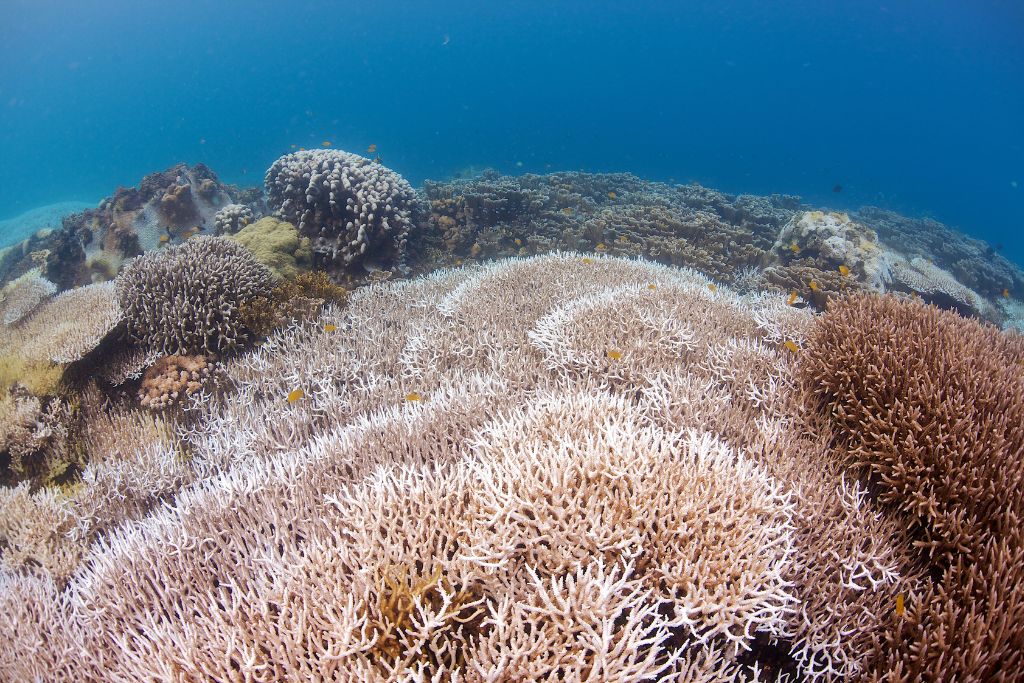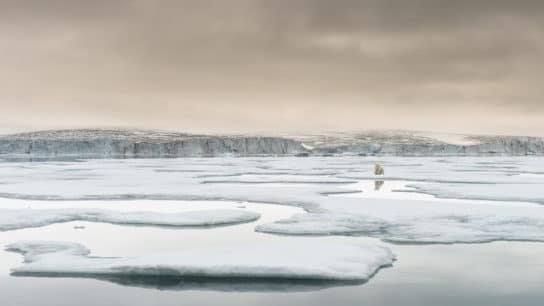Last year’s climate trends should be a “wake-up call that we are increasing the risks to our lives, economies and to the planet,” said World Meteorological Organization Secretary-General Celeste Saulo.
—
Highest atmospheric concentrations of carbon dioxide in 800,000 years, record ocean heat content and sea levels and lowest Arctic sea-ice extents. This is the grim picture emerging from a new report from the UN weather agency, which looked at changes in climate trends over the course of 2024, the hottest year on record.
These “distress signals” are “clear signs” of the impacts of human activities on our climate and environment, with some consequences deemed “irreversible over hundreds if not thousands of years,” the World Meteorological Organization’s (WMO) new State of the Climate report concluded.
2024 was the first calendar year of temperatures surpassing the key 1.5C warming limit set in the Paris Agreement, beyond which humanity will start experiencing severe climate damages across a wide range of ecosystems – some of which will be irreversible. WMO Secretary-General Celeste Saulo said that while one year above the critical threshold does not signal a permanent breach of the critical limit, which scientists say is measured over decades, it serves as “a wake-up call that we are increasing the risks to our lives, economies and to the planet.”
Last year also wrapped up a decade of unprecedented heat globally fuelled by human activities, with the last ten years making up the top ten hottest years on record.
The increase in extreme heat is a direct result of our warming planet, which is driven by greenhouse gases that trap heat in the atmosphere. This raises Earth’s surface temperature, leading to longer and hotter heatwaves.
Atmospheric concentrations of all three major planet-warming greenhouse gases – carbon dioxide (CO2), methane, and nitrous oxide – reached new highs in 2024, the report confirmed. In October, WMO Deputy Secretary-General Ko Barret said that because of these gases’ extremely long durability in the atmosphere, the world is now “committed to rising temperatures for many, many years to come."
Warmer temperatures are the main driver of more frequent and intense extreme weather events like tropical cyclones, floods, and droughts around the world, which last year led to the highest number of new displacements recorded for the past 16 years, according to the report.
So far, the world has warmed by 1.3C compared to pre-industrial times – with more than two-thirds (~1C) of this warming occurring since 1975.
Warmer Oceans
Each of the past eight years has set a new record for ocean heat content, according to the report, with 2024 seeing the highest level in the 65-year observational record. It also added that the rate of ocean warming over the past two decades (2005-2024) is more than twice that in the period 1960-2005.

Oceans are the world’s largest carbon sink – absorbing more than 90% of excess heat created through human-made greenhouse gasses and around 25% of carbon dioxide (CO2) emissions, resulting in ocean warming.
A 2019 report by the Intergovernmental Panel on Climate Change (IPCC) revealed that ocean warming events such as marine heatwaves are likely to increase as the climate crisis deteriorates, putting a greater strain on marine ecosystems such as corals, leading to ocean acidification and sea level rise, and altering ocean currents, resulting in massive die-offs of marine species, and dead zones due to oxygen depletion.
The world’s corals are currently undergoing a mass coral bleaching event in response to warmer oceans. The event is the largest ever recorded, affecting dozens of countries worldwide.
Highest Sea Levels
The global mean sea level reached its peak since satellite recordings began in 1993, rising at twice the rate between 2015 and 2024 compared to the 1993-2002 period, from 2.1 mm annually to 4.7 mm per year. The rise is related to the melting of glaciers and polar ice sheets as well as the natural expansion of water as it warms.

Over the past 20 years, the increase in sea levels has exacerbated coastal flooding, resulting in 14 million more individuals worldwide residing in coastal communities facing a 1-in-20 annual flood risk, 2023 data shows. If global greenhouse gas emissions continue at the current pace, it is estimated that by the end of the century, the number of people affected by coastal flooding will rise to 73 million.
Sea-Ice Content, Glacier Mass at Record Low
Over the past 18 years, the Arctic has witnessed its 18 lowest sea-ice extents on record, indicative of a concerning trend in the region, the report said. Similarly, the Antarctic has experienced its three lowest ice extents within the last three years.
The most substantial loss of glacier mass documented over a three-year period has also transpired in the recent past, highlighting the accelerated pace of environmental changes impacting polar regions.
The report also warned that the 2022-2024 period saw the most adverse glacier mass balance ever recorded, with seven out of the ten most unfavorable years since 1950 occurring post-2016. Norway, Sweden, Svalbard, and the tropical Andes regions were the most affected. Mass balance refers to "the total sum of all the accumulation (snow, ice, freezing rain) and melt or ice loss (from calving icebergs, melting, sublimation) across the entire glacier."
More on the topic: What Does Glacial Melting Tell Us About Our Changing Planet?
💡How can I contribute to a more sustainable planet?
- 🗳️ Vote for climate action: Exercise your democratic rights by supporting candidates and policies that prioritize climate change mitigation and environmental protection. Stay informed with Earth.Org's election coverage.
- 👣 Reduce your carbon footprint: Make conscious choices to reduce your carbon footprint. Opt for renewable energy sources, conserve energy at home, use public transportation or carpool, and embrace sustainable practices like recycling and composting.
- 💰 Support environmental organizations: Join forces with organizations like Earth.Org and its NGO partners, dedicated to educating the public on environmental issues and solutions, supporting conservation efforts, holding those responsible accountable, and advocating for effective environmental solutions. Your support can amplify their efforts and drive positive change.
- 🌱 Embrace sustainable habits: Make sustainable choices in your everyday life. Reduce single-use plastics, choose eco-friendly products, prioritize a plant-based diet and reduce meat consumption, and opt for sustainable fashion and transportation. Small changes can have a big impact.
- 💬 Be vocal, engage and educate others: Spread awareness about the climate crisis and the importance of environmental stewardship. Engage in conversations, share information, and inspire others to take action. Together, we can create a global movement for a sustainable future.
- 🪧 Stand with climate activists: Show your support for activists on the frontlines of climate action. Attend peaceful protests, rallies, and marches, or join online campaigns to raise awareness and demand policy changes. By amplifying their voices, you contribute to building a stronger movement for climate justice and a sustainable future.
For more actionable steps, visit our 'What Can I do?' page.
This story is funded by readers like you
Our non-profit newsroom provides climate coverage free of charge and advertising. Your one-off or monthly donations play a crucial role in supporting our operations, expanding our reach, and maintaining our editorial independence.
About EO | Mission Statement | Impact & Reach | Write for us














